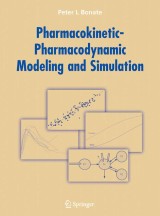Details

Pharmacokinetic-Pharmacodynamic Modeling and Simulation
|
76,99 € |
|
| Verlag: | Springer |
| Format: | |
| Veröffentl.: | 14.05.2006 |
| ISBN/EAN: | 9780387271996 |
| Sprache: | englisch |
| Anzahl Seiten: | 388 |
Dieses eBook enthält ein Wasserzeichen.
Beschreibungen
<P>A natural hierarchy exists in pharmacokinetic-pharmacodynamic modeling culminating in population pharmacokinetic models, which are a specific type of nonlinear mixed effects model. The purpose of this book is to present through theory and example how to develop pharmacokinetic models, both at an individual and population level. In order to do so, however, one must first understand linear models and then build to nonlinear models followed by linear mixed effects models and then ultimately nonlinear mixed effects models. This book develops in that manner – each chapter builds upon previous chapters by first presenting the theory and then illustrating the theory using published data sets and actual data sets that were used in the development of new chemical entities collected by the author during his years in industry. A key feature of the book is the process of modeling. Most books and manuscripts often present the final model never showing how the model evolved. In this book all examples are presented in an evolutionary manner.</P>
<P>A natural hierarchy exists in pharmacokinetic-pharmacodynamic modeling culminating in population pharmacokinetic models, which are a specific type of nonlinear mixed effects model. The purpose of this book is to present through theory and example how to develop pharmacokinetic models, both at an individual and population level. In order to do so, however, one must first understand linear models and then build to nonlinear models followed by linear mixed effects models and then ultimately nonlinear mixed effects models. This book develops in that manner – each chapter builds upon previous chapters by first presenting the theory and then illustrating the theory using published data sets and actual data sets that were used in the development of new chemical entities collected by the author during his years in industry. A key feature of the book is the process of modeling. Most books and manuscripts often present the final model never showing how the model evolved. In this book all examples are presented in an evolutionary manner.</P>
The Art of Modeling.- Linear Models and Regression.- Nonlinear Models and Regression.- Variance Models, Weighting, and Transformations.- Case Studies in Linear and Nonlinear Modeling.- Linear Mixed Effects Models.- Nonlinear Mixed Effects Models: Theory.- Nonlinear Mixed Effects Models: Practical Issues.- Nonlinear Mixed Effects Models: Case Studies.
<P>This book presents both the art and science behind pharmacokinetic-pharmacodynamic modeling. Using a building-block approach, the author starts from linear and nonlinear models at the individual level and proceeds to develop more complex linear and nonlinear mixed effects models at the population level, with particular emphasis on showing the interrelationships between the various model types. The theory behind the methods are illustrated using real data drawn from the literature and from the author’s own experiences in drug development. Data are analyzed using a variety of software, including SAS, WinNonlin, SAAM II, and NONMEM. A key component of the book is to show how models are accepted and rejected, ultimately leading to a useful and informative model that can be utilized using computer simulation to answer "what-if" questions.</P>
<p>There is no integrated book on pharmacokinetic-pharmacodynamic modeling that deals with the process of modeling or provides the necessary level of detail to train new modelers.</p><p>There is a dearth of pharmacokinetic modelers in industry and academia mainly because there are few training programs and no textbook on the subject. This book will help to fill the void.</p><p>Includes supplementary material: sn.pub/extras</p>
<P>Population pharmacokinetic models are a special type of nonlinear mixed effects model. This book shows through theory and example how to develop pharmacokinetic models, both at an individual and population level: each chapter builds upon previous chapters, first presenting the theory and then illustrating the theory using published data sets and actual data used in the development of new chemical entities ad collected by the author during his years in industry. Many books and manuscripts present the final model without showing how it evolved. This book presents all examples in an evolutionary manner.</P>
Diese Produkte könnten Sie auch interessieren:

Apoptotic Pathways as Targets for Novel Therapies in Cancer and Other Diseases

von: Marek Los, Spencer B. Gibson

149,79 €















